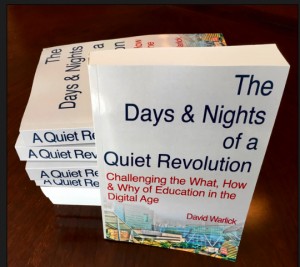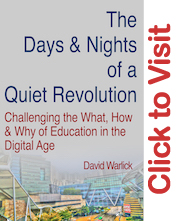I’m sitting here with my first stack of books for giveaway and thinking about why I called it, The Days & Nights of a Quiet Revolution. There’s nothing in it about education or even technology. I admit that many if not most of the participants in my workshops and audiences of my talks walked away thinking that it was about technology in education. That’s my failing. Educators, perhaps more than most professionals, are hyper focused on methodology of their job. When you have 20 to 40 students in your classroom, some of whom might be just as focused in disrupting your methods, big picture is a sky away from your notice.
I, on the other hand, spent my 40+ in education as a classroom teacher, a district administrator, part of a state-wide support staff and a parent. This gave me a unique perspective that encompassed both the day-to-day of classroom instruction, and the larger concerns of the why of education.

To be sure, it has not been a technology revolution, an idea that was difficult to convey to practicing teachers. I would stand in front of my audience and illustrate some technique that empowers learning by demonstrating a trick with my computer. Teachers, whose computers had been dumping into their classrooms and told to “integrate technology,” would see me demonstrating technology. The fact is that I was talking about a different way of education, one that goes back to Socrates and more recent education philosophers (Jean Piaget & John Dewey) – required reading for all practicing teachers. It’s an education that empowers students to become fearless and resourceful learners.
There were many of us mapping out new modes of teaching and learning with these new tools, and sharing them widely – and mostly, we did it during the days and nights of our own time. The index of my book includes a pretty good representation of their ranks, though not nearly complete. We were disrupters, and many teachers resisted our disruptive ideas, as they thwarted disruptive behavior in their classes. They resisted giving their students access to computers and the internet because they felt a loss of instructional control in their classrooms.
The greatest and most persistent force against our quiet revelation was not resistant teachers. It was a vision for computerized education held by an emerging education industrial complex. They were companies that saw the computer as a tool to better administer instruction on students, and they saw a market for products that could do that. Before 1990, companies were selling packaged technology solutions that included columns and rows of computers, equipped with software that drilled students in math and language arts, and required procedures, from which teachers were told not to deviate. All students were marched into and out of the computer room, regardless of their need or learning style. It irritated the kids, frustrated the teachers and disappointed administrators when they found that the rapid gains shown by the product were always short lived.
That was the late 1980s. Attempts to turn our classrooms into a marketplace and our children into compliant vessels continues, helped along by government legislation.
The Revolution Continues…


How true! You come up with some very creative and thoughtful/thought-provoking titles, David.
It’s really amazing how technology is changing the learning environment and really meeting the needs of learners!
The world of today, and tomorrow, certainly requires these ‘fearless and resourceful learners’ that you speak of. It is rather daunting to be tasked with empowering the learners of tomorrow, when one cannot imagine what lies ahead … ‘fearless and resourceful’ the teachers need to be too.